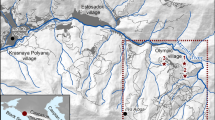Summary
In this study an attempt is made to examine and analyse the mean characteristics of the katabatic flows at the western slope foot of a 1024 m high knife edge mountain using a meteorological tower and three surface meteorological stations. In addition, the frequency distribution of the occurrence of the katabatic flow over one year period is studied along the characteristics of the flow arriving in the neighbouring urban area at a distance of 1.5 km. It was found that the katabatic flow occurs mainly in autumn and spring with the highest frequency in April. The flow is generally characterised by small depth as it is affected substantially by the background flow. The expected direction of the katabatic wind dominates mainly at the level of 7 m, where the influence of the background flow is minimised. At the level of 18 m the wind direction shifts, due to the interaction of the katabatic wind with the background flow. The katabatic flow can penetrate at a distance of 1.5 km being substantially weakened.
Similar content being viewed by others
Author information
Authors and Affiliations
Additional information
Received September 18, 1996 Revised August 4, 1997
Rights and permissions
About this article
Cite this article
Flocas, H., Helmis, C., Blikas, S. et al. Mean Characteristics of the Katabatic Flow of a 1024 m High Knife Edge Mountain. Theor Appl Climatol 59, 237–249 (1998). https://doi.org/10.1007/s007040050027
Issue Date:
DOI: https://doi.org/10.1007/s007040050027




